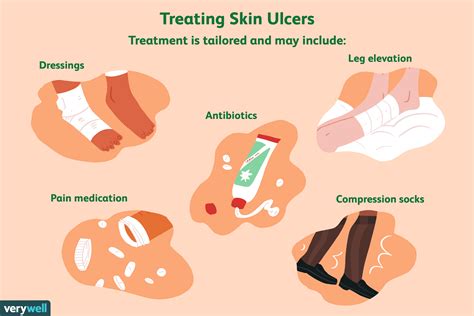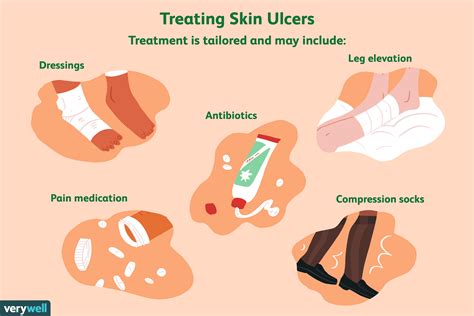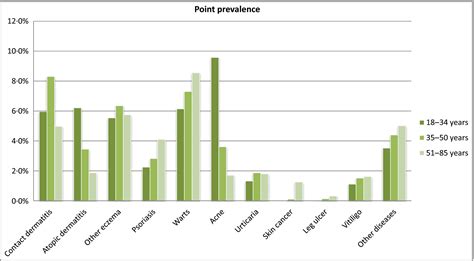Intro
Discover effective Skin Ulcer Disease Treatment options, including wound care, antibiotics, and surgical interventions, to manage symptoms and promote healing for chronic ulcers, diabetic foot ulcers, and pressure sores.
The prevalence of skin ulcer disease has been on the rise, affecting millions of people worldwide. This condition can be debilitating, causing significant discomfort, pain, and emotional distress. Skin ulcers are open sores that develop on the skin, often as a result of poor circulation, diabetes, or prolonged pressure on the skin. If left untreated, skin ulcers can lead to serious complications, including infection, amputation, and even death. Therefore, it is essential to seek medical attention if you or a loved one is suffering from skin ulcer disease. In this article, we will delve into the world of skin ulcer disease treatment, exploring the various options available, their benefits, and what you can expect from each.
The importance of seeking medical attention for skin ulcer disease cannot be overstated. Early diagnosis and treatment can significantly improve outcomes, reducing the risk of complications and promoting faster healing. There are various treatment options available, ranging from conservative management to surgical interventions. The choice of treatment depends on the severity of the ulcer, the underlying cause, and the individual's overall health. By understanding the different treatment options, you can make informed decisions about your care and work closely with your healthcare provider to develop an effective treatment plan.
Skin ulcer disease treatment is a complex and multifaceted field, requiring a comprehensive approach that addresses the physical, emotional, and psychological aspects of the condition. Healthcare providers must work together with patients to develop personalized treatment plans, taking into account their unique needs, preferences, and circumstances. This collaborative approach can help improve outcomes, enhance patient satisfaction, and reduce the risk of complications. As we explore the world of skin ulcer disease treatment, we will examine the various options available, their benefits, and what you can expect from each.
Skin Ulcer Disease Treatment Options

There are several treatment options available for skin ulcer disease, including conservative management, wound care, and surgical interventions. Conservative management involves treating the underlying cause of the ulcer, such as diabetes or poor circulation, and managing symptoms such as pain and discomfort. Wound care involves cleaning and dressing the ulcer, applying topical treatments, and using supportive devices such as compression stockings or orthotics. Surgical interventions may be necessary in severe cases, such as debridement, skin grafting, or amputation.
Conservative Management
Conservative management is often the first line of treatment for skin ulcer disease. This approach involves treating the underlying cause of the ulcer, managing symptoms, and preventing further complications. Conservative management may include lifestyle modifications, such as quitting smoking, exercising regularly, and eating a healthy diet. Medications may also be prescribed to manage underlying conditions, such as diabetes or high blood pressure.Wound Care
Wound care is a critical component of skin ulcer disease treatment. This involves cleaning and dressing the ulcer, applying topical treatments, and using supportive devices such as compression stockings or orthotics. Wound care can help promote healing, reduce the risk of infection, and improve overall outcomes. There are various wound care products available, including dressings, creams, and ointments. The choice of product depends on the severity of the ulcer, the stage of healing, and the individual's overall health.Benefits of Skin Ulcer Disease Treatment

The benefits of skin ulcer disease treatment are numerous, ranging from improved outcomes to enhanced quality of life. By seeking medical attention and receiving prompt treatment, individuals can reduce the risk of complications, promote faster healing, and improve overall health. Skin ulcer disease treatment can also help alleviate symptoms such as pain and discomfort, improving mobility and functionality. Additionally, treatment can help reduce the risk of infection, amputation, and other serious complications.
Improved Outcomes
Skin ulcer disease treatment can significantly improve outcomes, reducing the risk of complications and promoting faster healing. By addressing the underlying cause of the ulcer, managing symptoms, and preventing further complications, individuals can improve their overall health and well-being. Improved outcomes can also reduce the risk of hospitalization, amputation, and other serious complications.Enhanced Quality of Life
Skin ulcer disease treatment can also enhance quality of life, improving mobility, functionality, and overall well-being. By alleviating symptoms such as pain and discomfort, individuals can improve their daily functioning, engage in activities they enjoy, and maintain social connections. Enhanced quality of life can also reduce the risk of depression, anxiety, and other mental health conditions.Steps to Take for Skin Ulcer Disease Treatment

If you or a loved one is suffering from skin ulcer disease, there are several steps you can take to receive treatment and improve outcomes. The first step is to seek medical attention from a qualified healthcare provider. This may involve scheduling an appointment with a primary care physician, dermatologist, or wound care specialist. The healthcare provider will assess the ulcer, diagnose the underlying cause, and develop a personalized treatment plan.
Seek Medical Attention
Seeking medical attention is the first step in receiving skin ulcer disease treatment. This involves scheduling an appointment with a qualified healthcare provider, such as a primary care physician, dermatologist, or wound care specialist. The healthcare provider will assess the ulcer, diagnose the underlying cause, and develop a personalized treatment plan.Follow Treatment Plan
Following the treatment plan is critical to improving outcomes and promoting faster healing. This may involve taking medications, attending follow-up appointments, and making lifestyle modifications. Individuals should also keep the ulcer clean and dry, applying topical treatments and using supportive devices as directed.Practical Examples of Skin Ulcer Disease Treatment

There are several practical examples of skin ulcer disease treatment, ranging from conservative management to surgical interventions. For example, an individual with a diabetic foot ulcer may receive conservative management, including lifestyle modifications, medications, and wound care. Another example is an individual with a venous leg ulcer, who may receive compression therapy, wound care, and lifestyle modifications.
Case Study 1: Diabetic Foot Ulcer
A 65-year-old individual with diabetes presents with a foot ulcer on the bottom of their foot. The healthcare provider diagnoses a diabetic foot ulcer and develops a treatment plan, including lifestyle modifications, medications, and wound care. The individual is prescribed medications to manage their diabetes, attends follow-up appointments, and keeps the ulcer clean and dry. With prompt treatment, the individual is able to promote faster healing, reduce the risk of complications, and improve overall outcomes.Case Study 2: Venous Leg Ulcer
A 50-year-old individual presents with a leg ulcer on the inner aspect of their leg. The healthcare provider diagnoses a venous leg ulcer and develops a treatment plan, including compression therapy, wound care, and lifestyle modifications. The individual is prescribed compression stockings, attends follow-up appointments, and keeps the ulcer clean and dry. With prompt treatment, the individual is able to promote faster healing, reduce the risk of complications, and improve overall outcomes.Statistical Data on Skin Ulcer Disease Treatment

There are several statistical data on skin ulcer disease treatment, highlighting the importance of prompt medical attention and effective treatment. For example, studies have shown that individuals who receive prompt treatment for skin ulcers are more likely to experience improved outcomes, reduced risk of complications, and enhanced quality of life. Additionally, statistical data has shown that skin ulcer disease treatment can reduce the risk of hospitalization, amputation, and other serious complications.
Reduced Risk of Complications
Statistical data has shown that skin ulcer disease treatment can reduce the risk of complications, including infection, amputation, and death. By seeking medical attention and receiving prompt treatment, individuals can promote faster healing, improve overall outcomes, and reduce the risk of serious complications.Improved Quality of Life
Statistical data has also shown that skin ulcer disease treatment can improve quality of life, enhancing mobility, functionality, and overall well-being. By alleviating symptoms such as pain and discomfort, individuals can improve their daily functioning, engage in activities they enjoy, and maintain social connections.What are the symptoms of skin ulcer disease?
+The symptoms of skin ulcer disease may include pain, discomfort, swelling, redness, and drainage. Individuals may also experience fever, chills, and fatigue.
How is skin ulcer disease diagnosed?
+Skin ulcer disease is diagnosed through a physical examination, medical history, and diagnostic tests such as blood work and imaging studies.
What are the treatment options for skin ulcer disease?
+The treatment options for skin ulcer disease include conservative management, wound care, and surgical interventions. The choice of treatment depends on the severity of the ulcer, the underlying cause, and the individual's overall health.
In conclusion, skin ulcer disease treatment is a complex and multifaceted field, requiring a comprehensive approach that addresses the physical, emotional, and psychological aspects of the condition. By seeking medical attention and receiving prompt treatment, individuals can promote faster healing, reduce the risk of complications, and improve overall outcomes. We encourage readers to share their experiences, ask questions, and seek guidance from qualified healthcare providers. Together, we can work towards improving outcomes, enhancing quality of life, and reducing the burden of skin ulcer disease.
